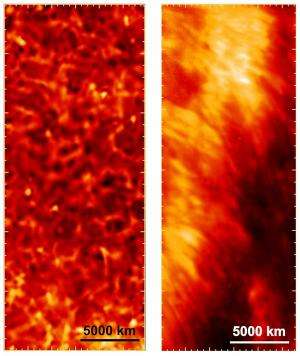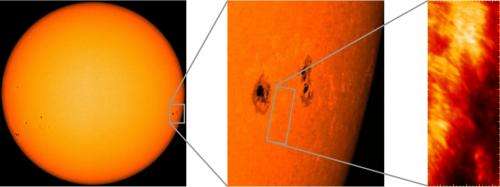SUNRISE offers new insight on sun's atmosphere

Three months after the flight of the solar observatory Sunrise – carried aloft by a NASA scientific balloon in early June 2013—scientists from the Max Planck Institute for Solar System Research in Germany have presented unique insights into a layer on the sun called the chromosphere. Sunrise provided the highest-resolution images to date in ultraviolet light of this thin corrugated layer, which lies between the sun's visible surface and the sun's outer atmosphere, the corona.
With its one-meter mirror, Sunrise is the largest solar telescope to fly above the atmosphere. The telescope weighed in at almost 7,000 pounds and flew some 20 miles up in the air. Sunrise was launched from Kiruna in the north of Sweden and, after five days drifting over the Atlantic, it landed on the remote Boothia Peninsula in northern Canada, gathering information about the chromosphere throughout its journey.
The temperature in the chromosphere rises from 6,000 K/10,340 F/5,272 C at the surface of the sun to about 20,000 K/ 35,540 F/19,730 C. It's an area that's constantly in motion, with different temperatures of hot material mixed over a range of heights, stretching from the sun's surface to many thousands of miles up. The temperatures continue to rise further into the corona and no one knows exactly what powers any of that heating.
"In order to solve this riddle it is necessary to take as close a look as possible at the chromosphere – in all accessible wavelengths," said Sami Solanki, the principal investigator for Sunrise from the Max Planck Institute. Sunrise used an instrument that was able to filter particular ultraviolet wavelengths of light that are only emitted from the chromosphere.

Sunrise's extremely high-resolution images in this wavelength painted a complex picture of the chromosphere. Where the sun is quiet and inactive, dark regions with a diameter of around 600 miles can be discerned surrounded by bright rims. This pattern is created by the enormous flows of solar material rising up from within the sun, cooling off and sinking down again. Especially eye-catching are bright points that flash up occasionally—much richer in contrast in these ultraviolet images than have been seen before. Scientists believe these bright points to be signs of what's called magnetic flux tubes, which are the building blocks of the sun's magnetic field. The magnetic field is of particular interest to scientists since it is ultimately responsible for all of the dynamic activity we see on our closest star.
"These first analyses are extremely promising," said Solanki. "They show that the ultraviolet radiation from the chromosphere is highly suitable for visualizing detailed structures and processes."
The researchers now hope that the next months will provide more new insights – and are looking forward to a close collaboration with colleagues from NASA's Interface Region Imaging Spectrograph, or IRIS mission. IRIS launched on June 27, only weeks after the end of the Sunrise mission, and also studies the ultraviolet radiation from chromosphere and corona. Michael Knoelker at the High Altitude Observatory in Boulder, Colo. Is the NASA principal investigator for Sunrise.
Provided by NASA's Goddard Space Flight Center



















